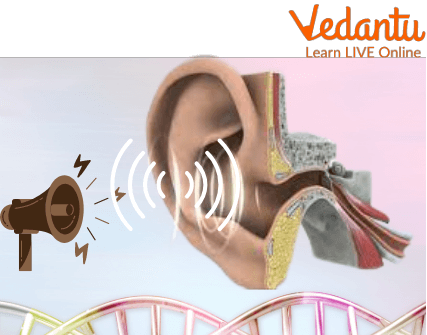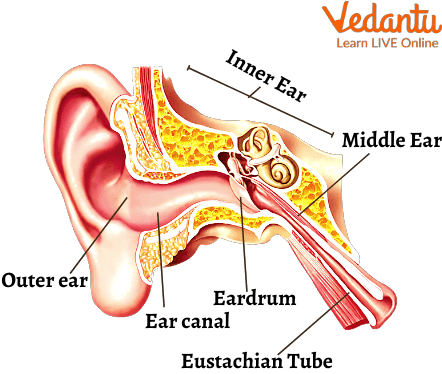




Why Are Human Ears Important? Essential Functions & Fun Facts
The ear is the main part of the hearing system in humans and other mammals. The ear is biologically similar in vertebrates from fish to humans, only its structure exhibits variation according to genus and species. The ear is the organ that senses sound; in addition to acting as a sound receiver, it also significantly contributes to the body's sense of balance and location. In this article, we will discuss the human ear. We will get to know about all the facts about ear like the use of tiny hairs, parts of ear and many other things. So without wasting any time, let’s dive in.

Human Ear
Tiny Hairs in Ears
The cochlea contains tiny hairs that vibrate when sound waves strike them. Sound waves are transformed into electrical signals by these hairs. To prevent dirt and debris from getting close to your eardrum, the hair right inside your ear interacts with earwax. Tiny hairs inside your ear aid in hearing and balance. Unlike the hair on your head, the hair cells in your ears are incredibly delicate, and they don't grow back. It's almost like baldness; once the hair is gone, it's gone for good.

Tiny Hairs in Ears
Human Ear
The auricle is the visible portion of the outer ear (pinna). Sound waves are gathered and sent into the ear's external auditory meatus, where they are amplified. The eardrum, also known as the tympanic membrane, is a flexible, oval membrane located at the outer end of the ear canal. A sensitive part of the human body is the ear. It focuses primarily on hearing, transmitting, and transducing sound. A further critical job that the human Ear does is maintaining balance.
How Do We Hear Sound?
The eardrum vibrates when there is sound because of sound vibrations. The inner ear receives vibrations from the eardrum or sound is a type of vibration or disturbance that is transmitted through a solid, liquid or gas. But only those vibrations are called sounds which are heard by the human ear. Instead of being an electromagnetic wave, sound is a mechanical wave. It takes a medium for sound to travel. The propagation of sound is possible in solid, liquid, gas and plasma. Sound cannot be transmitted in vacuum. It travels as a longitudinal wave whereas in solids it can also propagate as a transverse wave. When the particles of the medium vibrate perpendicular to the direction of motion of sound, it is called a transverse wave.

Ear Sound
Ear Facts
The ear is the organ that senses sound; in addition to acting as a sound receiver, it also significantly contributes to the body's sense of balance and location. Ears start to feel closed at high places. This is because the air is less dense at higher altitudes, which upsets the balance of air trapped in the middle ear. Air gets to the middle ear from the Eustachian tube which is connected to the throat. Usually it is closed but sometimes it remains open because it is necessary to balance the amount of air in the middle Ear. Animals have more hearing than humans. Once the hearing ability is lost, it cannot be cured.
Parts of Ear
The ear has three parts. The funnel-like eardrum and the tube-like passage leading to the eardrum is called the outer ear. Here earwax (wax) and foreign particles collect. The middle ear is located between the eardrum and the conch (labyrinth) of the inner ear. Antkarna is located in the bones. This conch shell converts the waves of sound (voice) and changes in body postures i.e. standing, lying down and sitting etc. into nerve signals. The nerve for hearing (the eighth brain nerve) carries these signals to the brain.
Outer Ear
It collects sound waves from the funnel or earlobe and transmits them to the eardrum. This causes vibrations in the eardrum. The skin of the cavernous passage of the outer ear secretes a greasy substance like normal skin. This substance collects and forms ear wax. The wax helps collect dust and other particles.
Middle Ear
It is connected to the nasal cavity by the Eustachian tube. The Eustachian nose may also be called the ENT (Ear Nose Throat) tube because it connects the ear, nose and throat. Due to this, the middle ear can withstand sudden changes in air pressure in the atmosphere. If suddenly the sound of an explosion or explosion hits the eardrum, it does not burst because this tremendous pressure goes through the ENT tube into the nasal cavity. But the difficulty is that this ENT tube also transmits infections of the nose and throat to the ear.
Inner Ear
Also called labyrinth, the inner ear or labyrinth is a conch-shaped structure. This conch is filled with liquid. It converts the vibrations of voice into nerve signals. These signals are carried to the brain by the eighth cranial nerve. The inner hair-like structures of the labyrinth vibrate according to the frequency of the sound waves.

Parts of Ear
Summary
To conclude all the conceptual understanding regarding ear in this article, we can say hearing and balance are sensed by the ear. The eardrum, which is stretched across the end of the auditory canal and sends sound vibrations to the middle ear, receives sound waves from the outer ear through the auditory canal. The vibrations are then transmitted to the inner ear by a chain made up of three small bones. We are wrapping up the article with this information. We have discussed so many things about ear in this article. Have a thorough reading and master this topic of Biology.
FAQs on Human Ears: Vital Facts, Functions & Structure Explained
1. What are the three parts of the human ear?
The 3 parts of the human ear are the outer ear, the middle ear and the inner ear. Each of these parts play a significant role in protecting our ear, helping us listen to sounds and maintain our body balance.
2. What should I do to clean my ears?
You can clean earwax with the help of lukewarm water. For this, warm the water a little and then put it inside the ear with the help of cotton. After holding for a few seconds, expel the water by turning it from the ear.
3. Name one disease in the ear.
Whistling sound in the ears is a disease. Some people also call it colloquially ringing in the ear. This is not a common problem, but a disease called tinnitus. In this disease, sound is heard inside the ear without any reason.









